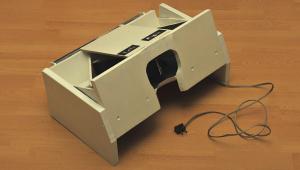Images & Gear; The Digital Challenge; Protecting Images And Gear On The Road
Digital technology has revolutionized photography. So much has changed. The terminology is different, the ability to make our images perfect after the fact is a new concept, and the instant gratification of seeing our photos in a microsecond allows us to correct our mistakes on the fly. At the same time, the digital world is fraught with challenges, and photographers have never had to deal with these things before. We are completely dependent on electricity, our priceless images are nothing more than positive and negative electrical charges that can vanish forever if a hard drive or a CompactFlash card has a hiccup, and it is a known fact that dust on the sensor has been responsible for driving many photographers into a padded cell. Not a pretty picture!
Fortunately, all the problems in the digital realm have solutions. The biggest problem of all is the need to back up your files. Hard drives and flash cards are machines that will fail at some point in the future. This is not a supposition. It’s a certainty. No one knows how long it will be before this happens, so you have to protect yourself from this eventuality. This is true with your files at home, and it’s certainly true of the pictures you take while traveling. Therefore, you have to have a backup strategy that is designed to assume the worst possible scenario.
Backup Strategies
At a bare minimum, you should have two backups of your images. I prefer four. It’s important to protect the investment in your travel pictures, and the only way to do that is to create redundancy.
There are three viable places to store images while traveling: a laptop computer, portable hard drives, and flash cards. I carry a laptop when I travel, and this is my first backup. From there, I copy the images onto two different drives. I use the LaCie “rugged” 500GB hard drive (www.lacie.com). I don’t need this much space for one trip’s photos, but I also carry with me my entire photo collection in case a client needs a photo, and I have extra space for my travel images.
Finally, when I fill up a flash card and copy the images to my laptop, I don’t reformat the card and use it again. Instead, I put it away as a fourth backup. I started doing this when the price of flash cards came down, and when a friend told me that he forgot a flash card in the pocket of his jeans and it went through the washing machine unscathed. He told me the pictures were fine. That suggested to me that this medium was very stable, and since they take up virtually no space, I felt this was added insurance that my travel pictures would be safe until I got home and copied them to the main hard drives in my office.
You can minimize the weight and volume of your equipment by not carrying a laptop. This is a reasonable choice. If you do a lot of backpacking or hiking, a laptop becomes a burden very fast both in terms of weight and because it’s so vulnerable to breakage. I like to carry one because I can surf the Internet when I have Wi-Fi access and I can use Skype to call home. I also like to work in Photoshop on my images when I have the time.
If you don’t travel with a laptop, then you’ll need a self-contained portable drive like the Epson P-6000 (www.epson.com). The advantage of the Epson unit is that you can see your images on the small screen and you can zoom in on them for close examination, delete them, and organize them before you get home. The LaCie rugged units I use don’t have that ability. However, the LaCie units are less than 25 percent of the cost of an Epson P-6000. In order to use the LaCie hard drives, though, you need a laptop because the photos on flash cards can’t be transferred directly to the drives. They first must be copied to the laptop and then to the LaCie drives. If you have an Epson P-6000, there is a slot for flash cards that enables you to transfer your images directly.
Foreign Electricity
Most other countries run on 220 volts as opposed to the American system of 110. Fortunately, you don’t need a transformer for your chargers, laptop, portable hard drives, and most of your other electronics. They have built-in circuits that automatically detect the local current, and they operate without a problem. The only thing you will need is an electrical adapter so the American-style plug can fit into their circuits. You can purchase these online or at most travel stores. Simply do a search on Google for “electrical adapters international” and you’ll find many companies that sell what you need.
If you buy a power strip with several plugs so you can charge many things at once, make sure you get one capable of handling the 220-volt current. I made that mistake last summer while traveling in Europe. I assumed the power strip I bought would work with both 110 and 220 volts. I had the correct adapter, but that didn’t matter. I shorted out the circuit in the hotel room and burned up the power strip. You can also find a 220 power strip online.
Protecting Sensitive Electronics
Traveling entails subjecting your equipment to a variety of hostile environments. Humidity, freezing temperatures, rain, salt spray in ocean environments, dust, and blowing sand are just some of the things that can damage your gear, or at the very least these factors can inhibit their full functionality. For example, when you are shooting in sub-zero weather, flash cards and batteries can become sluggish. The speed of the shutter can become slowed; in seriously cold weather, the blades that make up the shutter don’t open and close as fast as they should because the viscosity of the lubricant is reduced. It’s a good idea to carry chemical heat packets; these can be held against the battery compartment with touch fasteners to keep the electronics functional. This will give you many hours of critical warmth. You can’t use a rubber band because in severe cold it becomes brittle and will break. I discovered this when I was photographing baby harp seals (#1) in eastern Canada in -45°F.
 |
|
|
At the opposite end of the temperature spectrum is high humidity in hot climates. Going from an air-conditioned hotel room to the outdoors in places like Miami, Bangkok, and Bombay causes condensation on the front glass element of the lens as well as the entire camera body. Not only is picture taking impossible, but also condensed water drops can seep into crevices of the camera and cause problems. Cameras are sealed fairly well to protect the vulnerable electronics, but water has a way of finding its way into everything. Therefore, it’s a good idea to acclimate the gear to the outside temperature before opening the photo backpack or camera bag. I like to go outdoors 20 minutes before I anticipate taking any photographs to warm up the camera slowly. This prevents the condensation from occurring when it is taken out of the backpack.
 |
|
|
Blowing sand and dust can potentially be a lot more serious then humidity. When I was still shooting a medium format film camera in the early 1990s, I was doing landscape photography in southern Utah in a place popularly called “The Wave” (#2). The wind came up suddenly and I found myself in the middle of a sandstorm. I tried to protect my camera with my T-shirt, but wind-driven sand gets into everything. By the time the wind died down, I couldn’t even focus my lens without hearing the awful grinding sound of the sand inside the focusing ring. It cost me $800 to repair the damage, and some of the parts that had to be replaced were actually pitted from the force of the wind. When I now shoot in the desert, I carry a clear plastic shower cap with an elastic band that fits over my camera, and I also have a pillowcase into which I can put the plastic-covered camera. This offers double the protection. Sometimes the wind is low to the ground, and blowing sand hovers low around your feet. This is an insidious situation because you don’t feel the wind on your face but the sand is nevertheless terribly damaging. When I shot sand dunes in Namibia (#3) this is exactly what was happening. The sand gliding over the dunes made them seem like they were alive, and it was a stunning thing to see. But in terms of photo equipment, it was deadly.
 |
|
|

















































